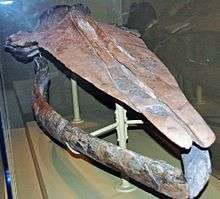Aglaocetus
Aglaocetus is a genus of extinct mysticete known from the Miocene of Patagonia, the US Eastern Seaboard, Japan and the Low Countries. It was once considered a member of Cetotheriidae along with many other putative cetotheres, but was recently recognized as representing a distinct family from true Cetotheriidae.
| Aglaocetus | |
|---|---|
 | |
| A. moreni skull | |
| Scientific classification | |
| Kingdom: | Animalia |
| Phylum: | Chordata |
| Class: | Mammalia |
| Order: | Artiodactyla |
| Infraorder: | Cetacea |
| Superfamily: | Balaenopteroidea |
| Family: | †Aglaocetidae Steeman 2007 |
| Genus: | †Aglaocetus Kellogg 1934 |
| Species | |
| |
| Synonyms | |
| |
Species

There are five currently recognized valid species: Aglaocetus moreni, A. latifrons, A. burtini, A. rotundus, and A. patulus.[1][2][3][4]
The type species, Aglaocetus moreni, was originally described as a species of Cetotherium, but later recognized as generically distinct from the latter.[5] Recent cladistic analysis failed to recover A. patulus in a monophyletic clade with the genus, suggesting that A. patulus deserves a new generic name.[6]
Distribution
Fossils of Aglaocetus have been found in:[7]
- Miocene
- Gaimán Formation (Colhuehuapian-Santacrucian), Argentina
- Diest and Berchem Formations, Belgium
- Korematsu Formation, Japan
- Eibergen Member, Netherlands
- United States
- Calvert and Choptank Formations, Maryland
- Calvert Formation, Virginia
References
- R. Lydekker. 1894. Cetacean skulls from Patagonia. Anales del Museo de la Plata II:1-13
- R. Kellogg. 1968. A sharp-nosed cetothere from the Miocene Calvert. Proceedings of the United States National Museum 247(7):163-173
- P. J. Van Beneden. 1859. Rapport de M. Van Beneden. Bulletins de L'Academie Royale des Sciences, des Lettres et des Beaux-Arts de Belgique 8:123-146
- P. J. Van Beneden. 1880. Les mysticetes a courts fanons des sables des environs d'anvers. Bulletins de L'Academie Royale des Sciences, des Lettres et des Beaux-Arts de Belgique 1880:11-27
- R. Kellogg. 1934. The Patagonian Fossil Whalebone Whale, Cetotherium moreni (Lydekker). Carnegie Institution of Washington 447:64-81
- M. Bisconti, O. Lambert, and M. Bosselaers. 2013. Taxonomic revision of Isocetus depauwi (Mammalia, Cetacea, Mysticeti) and the phylogenetic relationships of archaic 'cetothere' mysticetes. Palaeontology 56(1):95-127
- Aglaocetus at Fossilworks.org